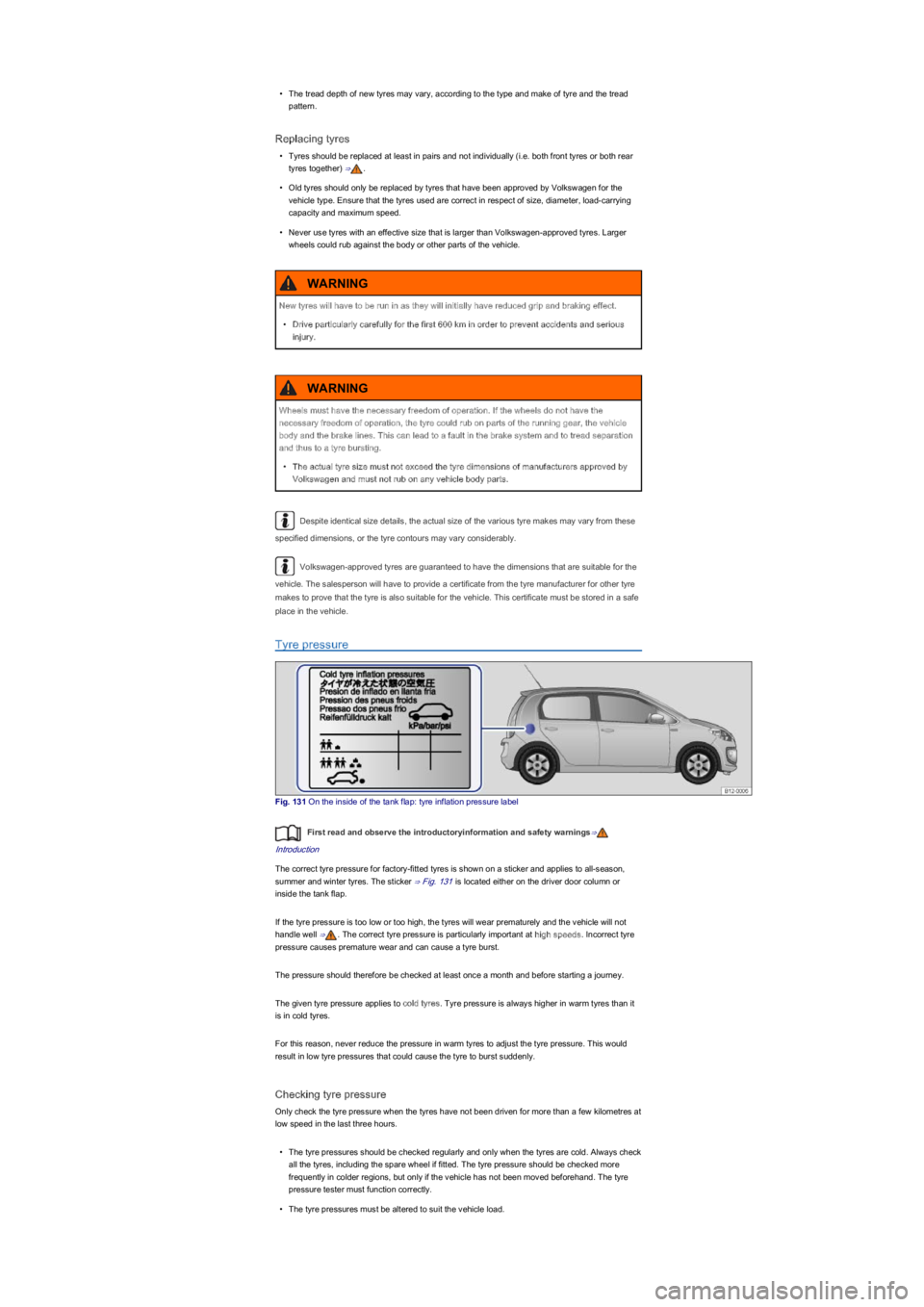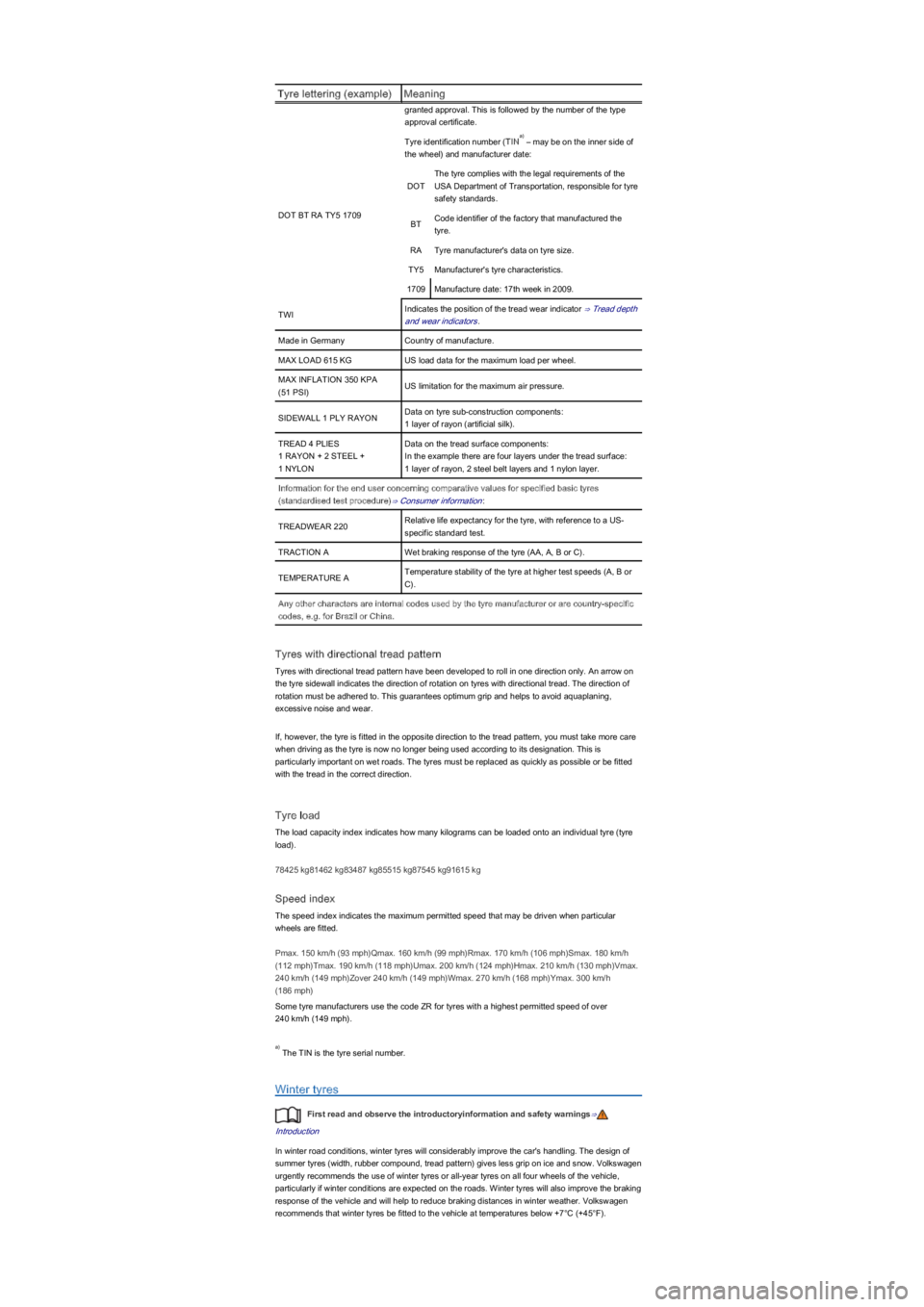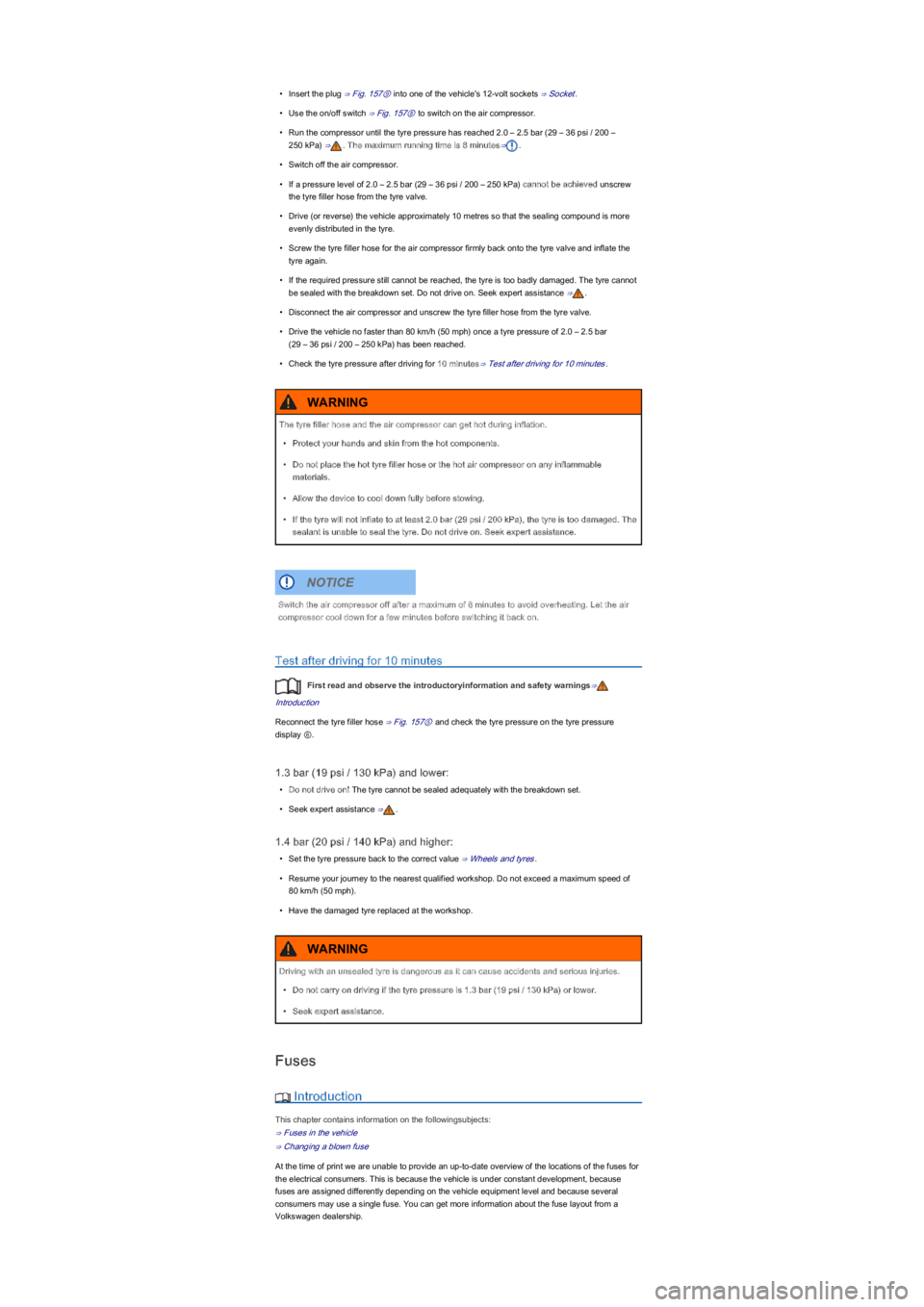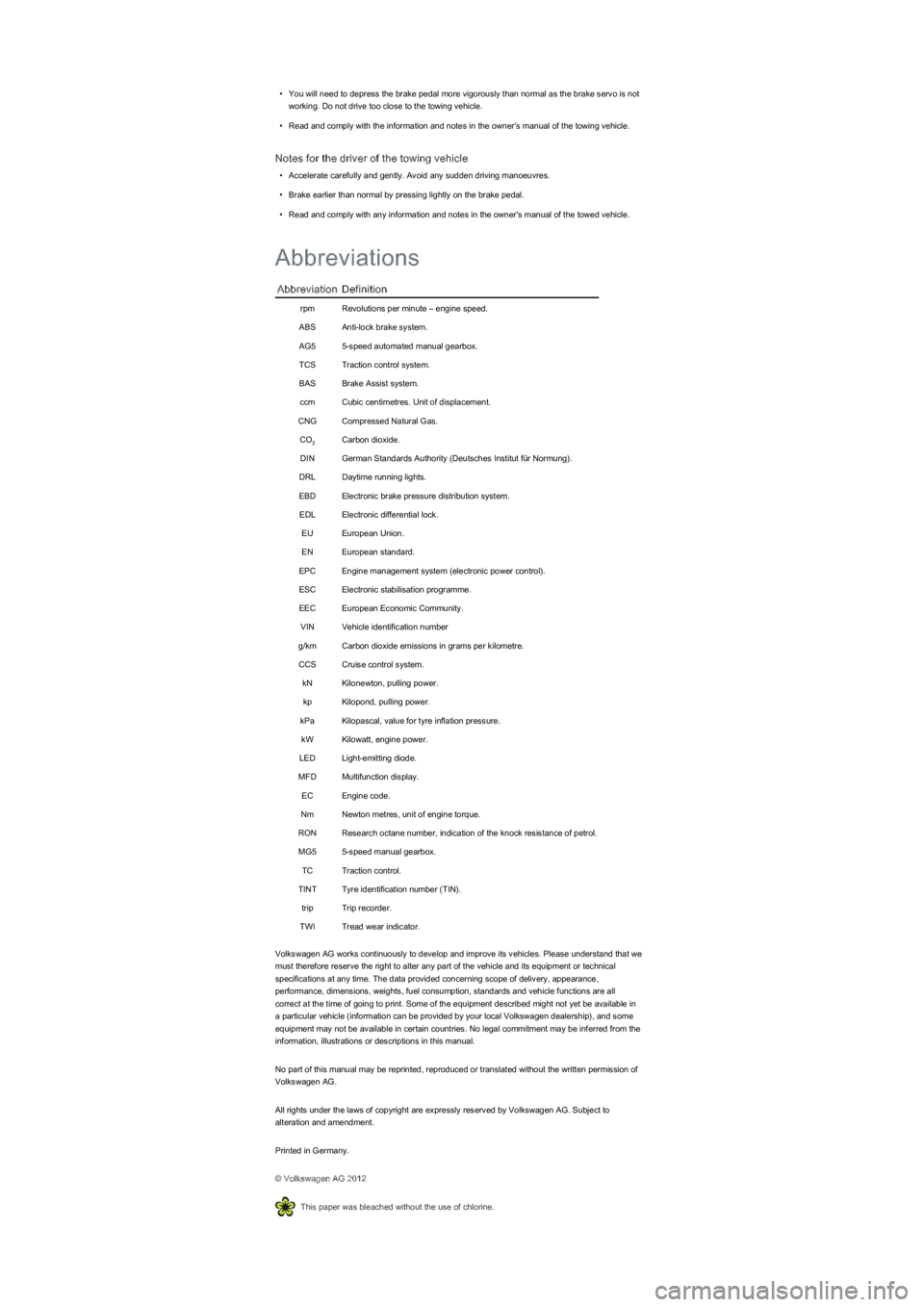inflation pressure VOLKSWAGEN UP! 2021 Owner´s Manual
[x] Cancel search | Manufacturer: VOLKSWAGEN, Model Year: 2021, Model line: UP!, Model: VOLKSWAGEN UP! 2021Pages: 211, PDF Size: 5.98 MB
Page 161 of 211

•The tread depth of new tyres may vary, according to the type and make of tyre and the tread
pattern.
Replacing tyres
•Tyres should be replaced at least in pairs and not individually (i.e. both front tyres or both rear
tyres together) ⇒.
•Old tyres should only be replaced by tyres that have been approved by Volkswagen for the
vehicle type. Ensure that the tyres used are correct in respect of size, diameter, load-carrying
capacity and maximum speed.
•Never use tyres with an effective size that is larger than Volkswagen-approved tyres. Larger
wheels could rub against the body or other parts of the vehicle.
Despite identical size details, the actual size of the various tyre makes may vary from these
specified dimensions, or the tyre contours may vary considerably.
Volkswagen-approved tyres are guaranteed to have the dimensions that are suitable for the
vehicle. The salesperson will have to provide a certificate from the tyre manufacturer for other tyre
makes to prove that the tyre is also suitable for the vehicle. This certificate must be stored in a safe
place in the vehicle.
Tyre pressure
Fig. 131 On the inside of the tank flap: tyre inflation pressure label
First read and observe the introductoryinformation and safety warnings⇒
Introduction
The correct tyre pressure for factory-fitted tyres is shown on a sticker and applies to all-season,
summer and winter tyres. The sticker ⇒ Fig. 131 is located either on the driver door column or
inside the tank flap.
If the tyre pressure is too low or too high, the tyres will wear prematurely and the vehicle will not
handle well ⇒. The correct tyre pressure is particularly important at high speeds. Incorrect tyre
pressure causes premature wear and can cause a tyre burst.
The pressure should therefore be checked at least once a month and before starting a journey.
The given tyre pressure applies to cold tyres. Tyre pressure is always higher in warm tyres than it
is in cold tyres.
For this reason, never reduce the pressure in warm tyres to adjust the tyre pressure. This would
result in low tyre pressures that could cause the tyre to burst suddenly.
Checking tyre pressure
Only check the tyre pressure when the tyres have not been driven for more than a few kilometres at
low speed in the last three hours.
•The tyre pressures should be checked regularly and only when the tyres are cold. Always check
all the tyres, including the spare wheel if fitted. The tyre pressure should be checked more
frequently in colder regions, but only if the vehicle has not been moved beforehand. The tyre
pressure tester must function correctly.
•The tyre pressures must be altered to suit the vehicle load.
New tyres will have to be run in as they will initially have reduced grip and braking effect.
•Drive particularly carefully for the first 600 km in order to prevent accidents and serious
injury.
WARNING
Wheels must have the necessary freedom of operation. If the wheels do not have the
necessary freedom of operation, the tyre could rub on parts of the running gear, the vehicle
body and the brake lines. This can lead to a fault in the brake system and to tread separation
and thus to a tyre bursting.
•The actual tyre size must not exceed the tyre dimensions of manufacturers approved by
Volkswagen and must not rub on any vehicle body parts.
WARNING
Page 166 of 211

Tyre lettering (example)Meaning
granted approval. This is followed by the number of the type
approval certificate.
DOT BT RA TY5 1709
Tyre identification number (TIN – may be on the inner side of
the wheel) and manufacturer date:
DOT
The tyre complies with the legal requirements of the
USA Department of Transportation, responsible for tyre
safety standards.
BTCode identifier of the factory that manufactured the
tyre.
RATyre manufacturer's data on tyre size.
TY5Manufacturer's tyre characteristics.
1709Manufacture date: 17th week in 2009.
TWIIndicates the position of the tread wear indicator ⇒ Tread depth
and wear indicators.
Made in GermanyCountry of manufacture.
MAX LOAD 615 KGUS load data for the maximum load per wheel.
MAX INFLATION 350 KPA
(51 PSI)US limitation for the maximum air pressure.
SIDEWALL 1 PLY RAYONData on tyre sub-construction components:
1 layer of rayon (artificial silk).
TREAD 4 PLIES
1 RAYON + 2 STEEL +
1 NYLON
Data on the tread surface components:
In the example there are four layers under the tread surface:
1 layer of rayon, 2 steel belt layers and 1 nylon layer.
Information for the end user concerning comparative values for specified basic tyres
(standardised test procedure)⇒ Consumer information:
TREADWEAR 220Relative life expectancy for the tyre, with reference to a US-
specific standard test.
TRACTION AWet braking response of the tyre (AA, A, B or C).
TEMPERATURE ATemperature stability of the tyre at higher test speeds (A, B or
C).
Any other characters are internal codes used by the tyre manufacturer or are country-specific
codes, e.g. for Brazil or China.
Tyres with directional tread pattern
Tyres with directional tread pattern have been developed to roll in one direction only. An arrow on
the tyre sidewall indicates the direction of rotation on tyres with directional tread. The direction of
rotation must be adhered to. This guarantees optimum grip and helps to avoid aquaplaning,
excessive noise and wear.
If, however, the tyre is fitted in the opposite direction to the tread pattern, you must take more care
when driving as the tyre is now no longer being used according to its designation. This is
particularly important on wet roads. The tyres must be replaced as quickly as possible or be fitted
with the tread in the correct direction.
Tyre load
The load capacity index indicates how many kilograms can be loaded onto an individual tyre (tyre
load).
78425 kg81462 kg83487 kg85515 kg87545 kg91615 kg
Speed index
The speed index indicates the maximum permitted speed that may be driven when particular
wheels are fitted.
Pmax. 150 km/h (93 mph)Qmax. 160 km/h (99 mph)Rmax. 170 km/h (106 mph)Smax. 180 km/h
(112 mph)Tmax. 190 km/h (118 mph)Umax. 200 km/h (124 mph)Hmax. 210 km/h (130 mph)Vmax.
240 km/h (149 mph)Zover 240 km/h (149 mph)Wmax. 270 km/h (168 mph)Ymax. 300 km/h
(186 mph)
Some tyre manufacturers use the code ZR for tyres with a highest permitted speed of over
240 km/h (149 mph).
The TIN is the tyre serial number.
Winter tyres
First read and observe the introductoryinformation and safety warnings⇒
Introduction
In winter road conditions, winter tyres will considerably improve the car's handling. The design of
summer tyres (width, rubber compound, tread pattern) gives less grip on ice and snow. Volkswagen
urgently recommends the use of winter tyres or all-year tyres on all four wheels of the vehicle,
particularly if winter conditions are expected on the roads. Winter tyres will also improve the braking
response of the vehicle and will help to reduce braking distances in winter weather. Volkswagen
recommends that winter tyres be fitted to the vehicle at temperatures below +7°C (+45°F).
a)
a)
Page 196 of 211

•Insert the plug ⇒ Fig. 157⑨ into one of the vehicle's 12-volt sockets ⇒ Socket.
•Use the on/off switch ⇒ Fig. 157⑧ to switch on the air compressor.
•Run the compressor until the tyre pressure has reached 2.0 – 2.5 bar (29 – 36 psi / 200 –
250 kPa) ⇒. The maximum running time is 8 minutes⇒.
•Switch off the air compressor.
•If a pressure level of 2.0 – 2.5 bar (29 – 36 psi / 200 – 250 kPa) cannot be achieved unscrew
the tyre filler hose from the tyre valve.
•Drive (or reverse) the vehicle approximately 10 metres so that the sealing compound is more
evenly distributed in the tyre.
•Screw the tyre filler hose for the air compressor firmly back onto the tyre valve and inflate the
tyre again.
•If the required pressure still cannot be reached, the tyre is too badly damaged. The tyre cannot
be sealed with the breakdown set. Do not drive on. Seek expert assistance ⇒.
•Disconnect the air compressor and unscrew the tyre filler hose from the tyre valve.
•Drive the vehicle no faster than 80 km/h (50 mph) once a tyre pressure of 2.0 – 2.5 bar
(29 – 36 psi / 200 – 250 kPa) has been reached.
•Check the tyre pressure after driving for 10 minutes⇒ Test after driving for 10 minutes.
Test after driving for 10 minutes
First read and observe the introductoryinformation and safety warnings⇒
Introduction
Reconnect the tyre filler hose ⇒ Fig. 157⑤ and check the tyre pressure on the tyre pressure
display ⑥.
1.3 bar (19 psi / 130 kPa) and lower:
•Do not drive on! The tyre cannot be sealed adequately with the breakdown set.
•Seek expert assistance ⇒.
1.4 bar (20 psi / 140 kPa) and higher:
•Set the tyre pressure back to the correct value ⇒ Wheels and tyres.
•Resume your journey to the nearest qualified workshop. Do not exceed a maximum speed of
80 km/h (50 mph).
•Have the damaged tyre replaced at the workshop.
Fuses
Introduction
This chapter contains information on the followingsubjects:
⇒ Fuses in the vehicle
⇒ Changing a blown fuse
At the time of print we are unable to provide an up-to-date overview of the locations of the fuses for
the electrical consumers. This is because the vehicle is under constant development, because
fuses are assigned differently depending on the vehicle equipment level and because several
consumers may use a single fuse. You can get more information about the fuse layout from a
Volkswagen dealership.
The tyre filler hose and the air compressor can get hot during inflation.
•Protect your hands and skin from the hot components.
•Do not place the hot tyre filler hose or the hot air compressor on any inflammable
materials.
•Allow the device to cool down fully before stowing.
•If the tyre will not inflate to at least 2.0 bar (29 psi / 200 kPa), the tyre is too damaged. The
sealant is unable to seal the tyre. Do not drive on. Seek expert assistance.
WARNING
Switch the air compressor off after a maximum of 8 minutes to avoid overheating. Let the air
compressor cool down for a few minutes before switching it back on.
NOTICE
Driving with an unsealed tyre is dangerous as it can cause accidents and serious injuries.
•Do not carry on driving if the tyre pressure is 1.3 bar (19 psi / 130 kPa) or lower.
•Seek expert assistance.
WARNING
Page 210 of 211

•You will need to depress the brake pedal more vigorously than normal as the brake servo is not
working. Do not drive too close to the towing vehicle.
•Read and comply with the information and notes in the owner's manual of the towing vehicle.
Notes for the driver of the towing vehicle
•Accelerate carefully and gently. Avoid any sudden driving manoeuvres.
•Brake earlier than normal by pressing lightly on the brake pedal.
•Read and comply with any information and notes in the owner's manual of the towed vehicle.
AbbreviationDefinition
rpmRevolutions per minute – engine speed.
ABSAnti-lock brake system.
AG55-speed automated manual gearbox.
TCSTraction control system.
BASBrake Assist system.
ccmCubic centimetres. Unit of displacement.
CNGCompressed Natural Gas.
COCarbon dioxide.
DINGerman Standards Authority (Deutsches Institut für Normung).
DRLDaytime running lights.
EBDElectronic brake pressure distribution system.
EDLElectronic differential lock.
EUEuropean Union.
ENEuropean standard.
EPCEngine management system (electronic power control).
ESCElectronic stabilisation programme.
EECEuropean Economic Community.
VINVehicle identification number
g/kmCarbon dioxide emissions in grams per kilometre.
CCSCruise control system.
kNKilonewton, pulling power.
kpKilopond, pulling power.
kPaKilopascal, value for tyre inflation pressure.
kWKilowatt, engine power.
LEDLight-emitting diode.
MFDMultifunction display.
ECEngine code.
NmNewton metres, unit of engine torque.
RONResearch octane number, indication of the knock resistance of petrol.
MG55-speed manual gearbox.
TCTraction control.
TINT Tyre identification number (TIN).
tripTrip recorder.
TWITread wear indicator.
Volkswagen AG works continuously to develop and improve its vehicles. Please understand that we
must therefore reserve the right to alter any part of the vehicle and its equipment or technical
specifications at any time. The data provided concerning scope of delivery, appearance,
performance, dimensions, weights, fuel consumption, standards and vehicle functions are all
correct at the time of going to print. Some of the equipment described might not yet be available in
a particular vehicle (information can be provided by your local Volkswagen dealership), and some
equipment may not be available in certain countries. No legal commitment may be inferred from the
information, illustrations or descriptions in this manual.
No part of this manual may be reprinted, reproduced or translated without the written permission of
Volkswagen AG.
All rights under the laws of copyright are expressly reserved by Volkswagen AG. Subject to
alteration and amendment.
Printed in Germany.
© Volkswagen AG 2012
This paper was bleached without the use of chlorine.
Abbreviations
2